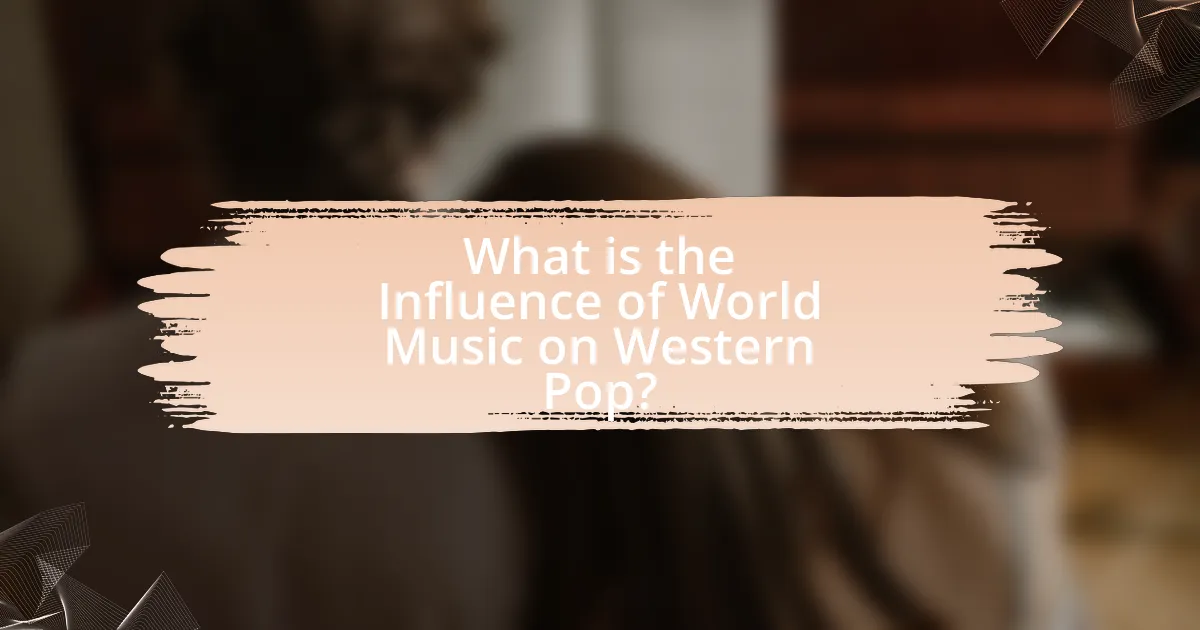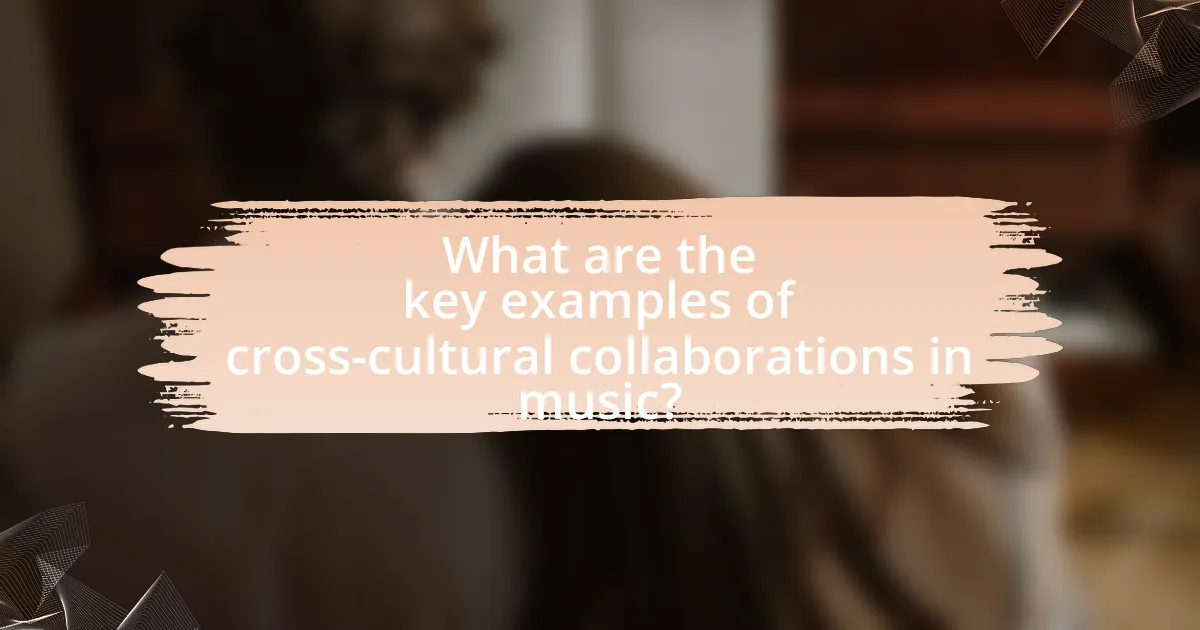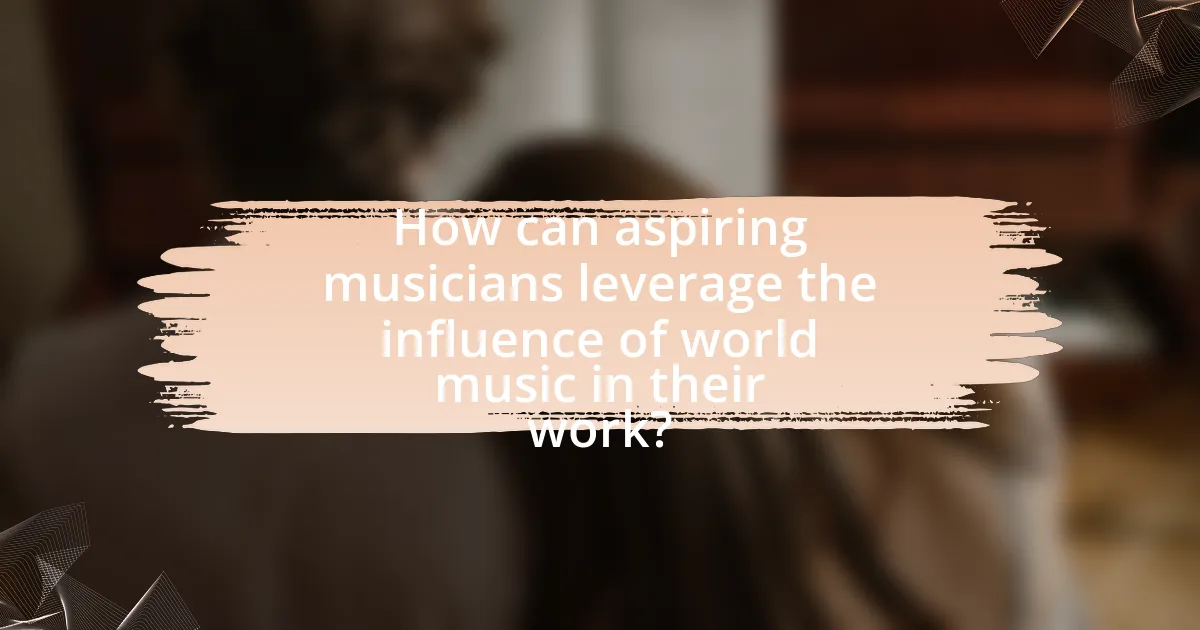The article examines the significant influence of world music on Western pop music, highlighting the integration of diverse rhythms, instruments, and cultural themes. It discusses how genres such as reggae, Afrobeat, and Flamenco have shaped contemporary pop, with notable examples including collaborations between artists like Paul Simon and Shakira. The piece emphasizes the importance of cross-cultural collaboration in fostering innovation and cultural appreciation, while also addressing the challenges artists face in these partnerships. Additionally, it provides insights into how aspiring musicians can incorporate world music elements into their work and the best practices for ensuring respectful representation of diverse cultures.

What is the Influence of World Music on Western Pop?
World music significantly influences Western pop by introducing diverse rhythms, instruments, and cultural themes. This cross-cultural exchange enriches the soundscape of pop music, as seen in the incorporation of Afrobeat, reggae, and Latin rhythms into mainstream tracks. For example, artists like Paul Simon in “Graceland” and Shakira with her blend of Colombian cumbia and pop have successfully integrated world music elements, leading to commercial success and critical acclaim. Additionally, the collaboration between Western artists and musicians from various cultural backgrounds, such as the partnership between Major Lazer and various international artists, exemplifies how world music shapes contemporary pop trends. This fusion not only broadens the appeal of Western pop but also fosters greater cultural appreciation and understanding.
How has world music shaped the sound of Western pop music?
World music has significantly shaped the sound of Western pop music by introducing diverse rhythms, instruments, and melodic structures. For instance, the incorporation of African rhythms in pop songs has led to the creation of genres like Afrobeat, which has influenced artists such as Paul Simon in “Graceland” and Beyoncé in “The Lion King: The Gift.” Additionally, the use of traditional instruments, such as the sitar in The Beatles’ “Norwegian Wood,” has expanded the sonic palette of Western pop. This blending of cultural elements has not only enriched the musical landscape but also fostered cross-cultural collaborations, exemplified by artists like Shakira, who integrates Latin sounds into mainstream pop. These influences demonstrate how world music has transformed Western pop into a more global and eclectic genre.
What specific genres of world music have had the most impact?
Reggae, Afrobeat, and Flamenco are specific genres of world music that have had significant impact on Western pop music. Reggae, originating from Jamaica, influenced artists like Bob Marley and has shaped genres such as hip-hop and rock. Afrobeat, pioneered by Fela Kuti, has contributed to the fusion of jazz, funk, and pop, impacting musicians like Paul Simon and the Red Hot Chili Peppers. Flamenco, with its intricate rhythms and emotional depth, has inspired artists like Paco de Lucía and has been integrated into various pop and rock music styles. These genres have not only enriched Western music but also fostered cross-cultural collaborations, demonstrating their lasting influence.
How do cultural elements from world music integrate into Western pop?
Cultural elements from world music integrate into Western pop through the incorporation of diverse musical styles, instruments, and rhythms. For example, the use of Afrobeat rhythms in songs by artists like Paul Simon in “Graceland” demonstrates how African musical traditions influence Western pop. Additionally, collaborations between Western artists and musicians from various cultural backgrounds, such as Shakira’s fusion of Latin sounds in her music, further exemplify this integration. The blending of these elements not only enriches the sound of Western pop but also reflects a growing appreciation for global musical diversity, as seen in the rise of genres like reggaeton and K-pop within mainstream Western music.
Why is cross-cultural collaboration important in music?
Cross-cultural collaboration is important in music because it fosters innovation and creativity by blending diverse musical styles and traditions. This collaboration allows artists to explore new sounds, rhythms, and lyrical themes, enriching their work and expanding their audience reach. For instance, the fusion of African rhythms with Western pop has led to the emergence of genres like Afrobeat, which has gained global popularity, demonstrating how cross-cultural interactions can create new musical landscapes. Additionally, studies show that such collaborations can enhance cultural understanding and appreciation, as artists share their unique backgrounds and perspectives through their music.
What are the benefits of collaboration between Western and world music artists?
Collaboration between Western and world music artists enhances cultural exchange and innovation in music. This synergy allows for the blending of diverse musical styles, resulting in unique sounds that appeal to broader audiences. For instance, the collaboration between American artist Paul Simon and South African musicians in the album “Graceland” introduced African rhythms to Western pop, significantly influencing the genre. Additionally, such partnerships can lead to increased visibility for world music artists in Western markets, fostering greater appreciation and understanding of different cultures. This mutual benefit not only enriches the artists’ creative expressions but also promotes global unity through shared musical experiences.
How do these collaborations enhance musical diversity?
Collaborations between artists from different cultural backgrounds enhance musical diversity by blending distinct musical styles, instruments, and traditions. For instance, the fusion of African rhythms with Western pop elements creates unique soundscapes that broaden the appeal of music across various demographics. A notable example is the collaboration between Paul Simon and South African musicians in the album “Graceland,” which introduced traditional South African music to a global audience, resulting in increased appreciation for diverse musical forms. Such partnerships not only enrich the listening experience but also promote cultural exchange and understanding, as evidenced by the growing popularity of genres like reggaeton and Afrobeat in mainstream music.
What historical events have influenced the blending of world music and Western pop?
The blending of world music and Western pop has been significantly influenced by historical events such as the globalization of music in the late 20th century, the civil rights movement in the United States, and the rise of technology in music distribution. The globalization of music, particularly in the 1980s and 1990s, facilitated cross-cultural exchanges, allowing artists from different backgrounds to collaborate and share their sounds. The civil rights movement, which emphasized cultural expression and diversity, encouraged the incorporation of various musical styles, particularly African and Latin influences, into mainstream pop. Additionally, advancements in technology, such as the internet and digital recording, have made it easier for artists worldwide to access and integrate diverse musical elements, further blending world music with Western pop.
How did globalization affect the exchange of musical styles?
Globalization significantly enhanced the exchange of musical styles by facilitating cross-cultural collaborations and the dissemination of diverse musical influences. This phenomenon is evident in the rise of genres such as Reggaeton, which blends Latin rhythms with hip-hop and electronic music, showcasing how artists from different backgrounds can create new sounds together. Additionally, platforms like the internet and social media have allowed musicians to share their work globally, leading to increased exposure and fusion of various musical traditions. For instance, the collaboration between American pop artists and African musicians has resulted in hits that incorporate traditional African instruments and rhythms, illustrating the tangible impact of globalization on music.
What role did technology play in promoting cross-cultural music?
Technology played a crucial role in promoting cross-cultural music by facilitating global communication and collaboration among artists. Innovations such as the internet, digital recording software, and streaming platforms have enabled musicians from diverse backgrounds to share their work and collaborate regardless of geographical barriers. For instance, platforms like YouTube and Spotify allow artists to reach international audiences, leading to the fusion of different musical styles and genres. Additionally, social media has provided a space for cultural exchange, where artists can connect and influence each other, exemplified by collaborations like Shakira’s “Waka Waka” featuring African rhythms, which gained worldwide popularity. This technological integration has not only broadened the accessibility of world music but also enriched the Western pop music landscape through diverse influences.

What are the key examples of cross-cultural collaborations in music?
Key examples of cross-cultural collaborations in music include the collaboration between Paul Simon and South African musicians on the album “Graceland,” which integrated traditional African rhythms and styles into Western pop music. Another significant example is the partnership between the American band The Black Eyed Peas and the Colombian singer Shakira, particularly in the song “Girl Like Me,” which blends Latin influences with hip-hop. Additionally, the collaboration between the Indian composer A.R. Rahman and the British musician Andrew Lloyd Webber on the musical “Bombay Dreams” showcases a fusion of Indian classical music with Western musical theater. These collaborations illustrate the blending of diverse musical traditions, enriching the global music landscape.
Which artists are known for their successful collaborations across cultures?
Artists known for their successful collaborations across cultures include Shakira, who has blended Latin and pop music with artists like Wyclef Jean and Rihanna, and Yo-Yo Ma, a cellist recognized for his work with musicians from various genres, including traditional African and Indian music. Additionally, the Black Eyed Peas have collaborated with artists like J Balvin, merging hip-hop with reggaeton. These collaborations highlight the fusion of diverse musical styles and cultural influences, demonstrating the global nature of contemporary music.
What are some notable songs that exemplify this fusion?
Notable songs that exemplify the fusion of world music and Western pop include “Despacito” by Luis Fonsi featuring Daddy Yankee, which incorporates reggaeton and Latin rhythms, and “Bamboo” by the band The Black Eyed Peas, which blends hip-hop with traditional Filipino sounds. Additionally, “Paper Planes” by M.I.A. features elements of South Asian music, showcasing a cross-cultural collaboration that resonates globally. These songs illustrate how diverse musical influences can create commercially successful and culturally rich compositions.
How have these collaborations been received by audiences and critics?
Collaborations between world music artists and Western pop musicians have generally been well-received by both audiences and critics. Many listeners appreciate the fusion of diverse musical styles, which often results in innovative and refreshing sounds. For instance, the collaboration between Shakira and Wyclef Jean on “Hips Don’t Lie” received widespread acclaim, topping charts globally and earning multiple awards. Critics have noted that such partnerships not only broaden the appeal of the artists involved but also promote cultural exchange, enhancing the richness of the music landscape. This positive reception is further evidenced by the commercial success of albums featuring cross-cultural collaborations, which often achieve high sales and streaming numbers, indicating strong audience engagement.
What impact do these collaborations have on the artists involved?
Collaborations between artists from different cultural backgrounds significantly enhance the creative output and market reach of the involved artists. These partnerships often lead to the fusion of diverse musical styles, resulting in innovative sounds that attract wider audiences. For instance, collaborations like those between Shakira and Wyclef Jean have not only produced chart-topping hits but also expanded their fan bases across different demographics. Additionally, such collaborations can increase visibility in international markets, as seen with the success of artists like Major Lazer, who blend electronic music with various world music influences, thereby gaining global recognition. This cross-cultural exchange enriches the artists’ artistic repertoire and fosters cultural appreciation among their audiences.
How do artists benefit creatively from working with musicians from different cultures?
Artists benefit creatively from working with musicians from different cultures by gaining access to diverse musical styles, techniques, and perspectives that enhance their own artistic expression. This collaboration fosters innovation, as artists can blend different genres, rhythms, and instruments, leading to unique soundscapes that may not have been possible within their own cultural confines. For instance, the fusion of traditional African rhythms with Western pop has resulted in new genres like Afrobeats, which have gained global popularity. Such cross-cultural collaborations not only expand an artist’s creative toolkit but also promote cultural exchange and understanding, enriching the artistic landscape.
What challenges do artists face in cross-cultural collaborations?
Artists face several challenges in cross-cultural collaborations, primarily including communication barriers, differing artistic expectations, and cultural misunderstandings. Communication barriers arise from language differences, which can hinder effective dialogue and collaboration. Differing artistic expectations often stem from varying cultural norms and practices, leading to conflicts in creative vision. Cultural misunderstandings can result in unintentional offense or misrepresentation, as artists may not fully grasp the significance of certain cultural elements. These challenges can impede the collaborative process and affect the final artistic output.

How can aspiring musicians leverage the influence of world music in their work?
Aspiring musicians can leverage the influence of world music by incorporating diverse rhythms, instruments, and cultural themes into their compositions. This approach not only enriches their sound but also broadens their audience appeal. For instance, artists like Shakira and M.I.A. have successfully integrated elements from Latin and South Asian music, respectively, which has led to chart-topping hits and increased global recognition. Additionally, collaborations with world music artists can provide authenticity and new perspectives, as seen in the work of artists like Paul Simon, who blended African musical styles in his album “Graceland,” resulting in critical acclaim and commercial success. By embracing these elements, musicians can create innovative and culturally resonant music that stands out in a competitive industry.
What strategies can musicians use to incorporate world music elements?
Musicians can incorporate world music elements by blending traditional instruments, rhythms, and scales from various cultures into their compositions. For instance, using instruments like the sitar or djembe can add unique textures and sounds that are characteristic of specific regions. Additionally, musicians can study and integrate diverse rhythmic patterns, such as the polyrhythms found in African music or the intricate time signatures in Indian classical music, to create a more complex and engaging sound. Collaborating with artists from different cultural backgrounds can also provide authentic insights and techniques, enhancing the fusion of styles. This approach is supported by the success of artists like Paul Simon, who incorporated South African music in his album “Graceland,” demonstrating how cross-cultural collaboration can lead to innovative musical expressions.
How can understanding different musical traditions enhance a musician’s creativity?
Understanding different musical traditions enhances a musician’s creativity by providing diverse influences and techniques that can be integrated into their own work. Exposure to various scales, rhythms, and cultural contexts allows musicians to break free from conventional patterns, fostering innovation. For instance, the incorporation of African polyrhythms in Western pop music has led to unique sounds and styles, as seen in the works of artists like Paul Simon and his album “Graceland,” which blended South African music with Western pop. This cross-cultural collaboration not only enriches the musician’s repertoire but also broadens their artistic perspective, ultimately leading to more original and varied compositions.
What resources are available for learning about world music styles?
Resources for learning about world music styles include online platforms, academic courses, and books. Websites like Coursera and edX offer courses on world music, often taught by university professors, providing structured learning. Additionally, the Smithsonian Folkways Recordings archive offers extensive audio resources and educational materials on various global music traditions. Books such as “World Music: A Global Journey” by Andrew Shahriari provide comprehensive insights into different music styles and their cultural contexts. These resources collectively facilitate a deeper understanding of world music and its influence on genres like Western pop.
What are the best practices for collaborating with artists from different cultures?
The best practices for collaborating with artists from different cultures include fostering open communication, respecting cultural differences, and engaging in mutual learning. Open communication ensures that all parties express their ideas and concerns, which is crucial for understanding diverse perspectives. Respecting cultural differences involves acknowledging and valuing the unique traditions and practices of each artist, which can enhance creativity and collaboration. Engaging in mutual learning allows artists to share their cultural backgrounds and artistic techniques, leading to richer and more innovative outcomes. These practices are supported by successful collaborations in the music industry, such as the partnership between American artist Paul Simon and South African musicians, which resulted in the critically acclaimed album “Graceland,” showcasing the benefits of cross-cultural exchange.
How can musicians ensure respectful and authentic representation of diverse cultures?
Musicians can ensure respectful and authentic representation of diverse cultures by engaging in thorough research and collaboration with cultural representatives. This involves understanding the historical and social contexts of the cultures they wish to represent, which helps avoid stereotypes and misinterpretations. For instance, artists like Paul Simon collaborated with South African musicians during the creation of “Graceland,” which not only showcased authentic sounds but also highlighted the cultural significance of the music. Additionally, musicians should seek feedback from cultural insiders to validate their interpretations and ensure they honor the traditions they are drawing from. This approach fosters genuine connections and promotes cultural appreciation rather than appropriation.
What steps should artists take to promote their cross-cultural collaborations effectively?
Artists should leverage social media platforms to promote their cross-cultural collaborations effectively. By utilizing platforms like Instagram, Facebook, and TikTok, artists can reach diverse audiences and showcase their collaborative work through engaging content such as videos, behind-the-scenes footage, and live performances. Research indicates that social media marketing can increase audience engagement by up to 80%, making it a powerful tool for artists to connect with fans globally. Additionally, artists should collaborate with influencers from different cultures to amplify their reach and credibility, as partnerships with established figures can enhance visibility and attract new listeners.